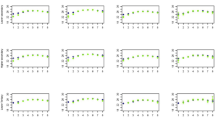Abstract
In survey statistics, simulation studies are usually performed by repeatedly drawing samples from population data. Furthermore, population data may be used in courses on survey statistics to support the theory by practical examples. However, real population data containing the information of interest are in general not available, therefore synthetic data need to be generated. Ensuring data confidentiality is thereby absolutely essential, while the simulated data should be as realistic as possible. This paper briefly outlines a recently proposed method for generating close-to-reality population data for complex (household) surveys, which is applied to generate a population for Austrian EU-SILC (European Union Statistics on Income and Living Conditions) data. Based on this synthetic population, confidentiality issues are discussed using five different worst case scenarios. In all scenarios, the intruder has the complete information on key variables from the real survey data. It is shown that even in these worst case scenarios the synthetic population data are confidential. In addition, the synthetic data are of high quality.
This work was partly funded by the European Union (represented by the European Commission) within the 7th framework programme for research (Theme 8, Socio-Economic Sciences and Humanities, Project AMELI (Advanced Methodology for European Laeken Indicators), Grant Agreement No. 217322). For more information on the project, visit http://ameli.surveystatistics.net
Access this chapter
Tax calculation will be finalised at checkout
Purchases are for personal use only
Preview
Unable to display preview. Download preview PDF.
Similar content being viewed by others
References
Münnich, R., Schürle, J., Bihler, W., Boonstra, H.-J., Knotterus, P., Nieuwenbroek, N., Haslinger, A., Laaksonen, S., Eckmair, D., Quatember, A., Wagner, H., Renfer, J.-P., Oetliker, U., Wiegert, R.: Monte Carlo simulation study of European surveys. In: DACSEIS Deliverables D3.1 and D3.2, University of Tübingen (2003)
Chambers, R.: Evaluation criteria for statistical editing and imputation. In: EurEdit Deliverable D3.3, Department of Social Statistics, University of Southhampton (2001)
Alfons, A., Templ, M., Filzmoser, P., Kraft, S., Hulliger, B.: Intermediate report on the data generation mechanism and on the design of the simulation study. In: AMELI Deliverable 6.1, Vienna University of Technology (2009)
Münnich, R., Schürle, J.: On the simulation of complex universes in the case of applying the German Microcensus. DACSEIS research paper series, vol. 4. University of Tübingen (2003)
Alfons, A., Kraft, S., Templ, M., Filzmoser, P.: Simulation of synthetic population data for household surveys with application to EU-SILC. Research Report CS-2010-1, Department of Statistics and Probability Theory, Vienna University of Technology (2010), http://www.statistik.tuwien.ac.at/forschung/CS/CS-2010-1complete.pdf
Clarke, G.P.: Microsimulation: an introduction. In: Clarke, G.P. (ed.) Microsimulation for Urban and Regional Policy Analysis, Pion, London (1996)
Rubin, D.B.: Discussion: Statistical disclosure limitation. J. Off. Stat. 9(2), 461–468 (1993)
Little, R.J.A.: Statistical analysis of masked data. J. Off. Stat. 9(2), 407–426 (1993)
Raghunathan, T.E., Reiter, J.P., Rubin, D.B.: Multiple imputation for statistical disclosure limitation. J. Off. Stat. 19(1), 1–16 (2003)
Drechsler, J., Bender, S., Rässler, S.: Comparing fully and partially synthetic datasets for statistical disclosure control in the German IAB Establishment Panel. Trans. Data Priv. 1(3), 105–130 (2008)
Reiter, J.P.: Using multiple imputation to integrate and disseminate confidential microdata. Int. Stat. Rev. 77(2), 179–195 (2009)
Horvitz, D.G., Thompson, D.J.: A generalization of sampling without replacement from a finite universe. J. Am. Stat. Assoc. 47(260), 663–685 (1952)
R Development Core Team. R: A Language and Environment for Statistical Computing. R Foundation for Statistical Computing, Vienna (2010) ISBN 3-900051-07-0, http://www.r-project.org
Kraft, S., Alfons, A.: simPopulation: Simulation of synthetic populations for surveys based on sample data, R package version 0.1.2 (2010)
Atkinson, T., Cantillon, B., Marlier, E., Nolan, B.: Social Indicators: The EU and Social Inclusion. Oxford University Press, New York (2002), ISBN: 0-19-925349-8
Eurostat. Description of target variables: Cross-sectional and longitudinal. EU-SILC 065/04, Eurostat, Luxembourg (2004)
Kraft, S.: Simulation of a Population for the European Living and Income Conditions Survey. Master’s thesis, Vienna University of Technology (2009)
Rinott, Y., Shlomo, N.: A generalized negative binomial smoothing model for sample disclosure risk estimation. In: Domingo-Ferrer, J., Franconi, L. (eds.) PSD 2006. LNCS, vol. 4302, pp. 82–93. Springer, Heidelberg (2006) ISBN 978-3-540-49330-3
Elamir, E.A.H., Skinner, C.J.: Record level measures of disclosure risk for survey microdata. J. Off. Stat. 22(3), 525–539 (2006)
Templ, M.: New Developments in Statistical Disclosure Control and Imputation: Robust Statistics Applied to Official Statistics. Südwestdeutscher Verlag für Hochschulschriften, Germany (2009) ISBN 3838108280
Samarati, P., Sweeney, L.: Protecting privacy when disclosing information: k-anonymity and its enforcement through generalization and suppression. Technical Report SRI-CSL-98-04, SRI International (1998)
Sweeney, L.: k-anonymity: a model for protecting privacy. Int. J. Uncertain. Fuzziness Knowl. Syst. 10(5), 557–570 (2002)
Franconi, L., Polettini, S.: Individual risk estimation in μ-ARGUS: A review. In: Domingo-Ferrer, J., Torra, V. (eds.) Privacy in Statistical Databases. LNCS, vol. 3050, pp. 262–272. Springer, Heidelberg (2004) ISBN 978-3-540-22118-2
Domingo-Ferrer, J., Mateo-Sanz, J.M.: Practical data-oriented microaggregation for statistical disclosure control. IEEE Trans. Knowl. Data Eng. 14(1), 189–201 (2002)
Templ, M., Meindl, B.: Robust statistics meets SDC: New disclosure risk measures for continuous microdata masking. In: Domingo-Ferrer, J., Saygın, Y. (eds.) PSD 2008. LNCS, vol. 5262, pp. 113–126. Springer, Heidelberg (2008) ISBN 978-3-540-87470-6
Reiter, J.P., Mitra, R.: Estimating risks of identification disclosure in partially synthetic data. J. Priv. Confid. 1(1), 99–110 (2009)
Duncan, G.T., Lambert, D.: Disclosure-limited data dissemination. J. Am. Stat. Assoc. 81(393), 10–28 (1986)
Fienberg, S.E., Makov, U.E., Sanil, A.P.: A bayesian approach to data disclosure: Optimal intruder behavior for continuous data. J. Off. Stat. 13(1), 75–89 (1997)
Akaike, H.: Statistical predictor identification. Ann. Inst. Stat. Math. 22(2), 203–217 (1970)
Author information
Authors and Affiliations
Editor information
Editors and Affiliations
Rights and permissions
Copyright information
© 2010 Springer-Verlag Berlin Heidelberg
About this paper
Cite this paper
Templ, M., Alfons, A. (2010). Disclosure Risk of Synthetic Population Data with Application in the Case of EU-SILC. In: Domingo-Ferrer, J., Magkos, E. (eds) Privacy in Statistical Databases. PSD 2010. Lecture Notes in Computer Science, vol 6344. Springer, Berlin, Heidelberg. https://doi.org/10.1007/978-3-642-15838-4_16
Download citation
DOI: https://doi.org/10.1007/978-3-642-15838-4_16
Publisher Name: Springer, Berlin, Heidelberg
Print ISBN: 978-3-642-15837-7
Online ISBN: 978-3-642-15838-4
eBook Packages: Computer ScienceComputer Science (R0)




